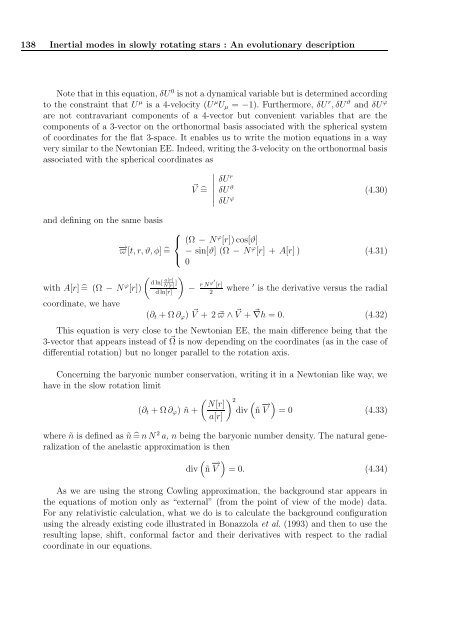Ecole doctorale de Physique de la région Parisienne (ED107)
Ecole doctorale de Physique de la région Parisienne (ED107)
Ecole doctorale de Physique de la région Parisienne (ED107)
You also want an ePaper? Increase the reach of your titles
YUMPU automatically turns print PDFs into web optimized ePapers that Google loves.
138 Inertial mo<strong>de</strong>s in slowly rotating stars : An evolutionary <strong>de</strong>scription<br />
Note that in this equation, δU 0 is not a dynamical variable but is <strong>de</strong>termined according<br />
to the constraint that U µ is a 4-velocity (U µ Uµ = −1). Furthermore, δU r , δU ϑ and δU ϕ<br />
are not contravariant components of a 4-vector but convenient variables that are the<br />
components of a 3-vector on the orthonormal basis associated with the spherical system<br />
of coordinates for the f<strong>la</strong>t 3-space. It enables us to write the motion equations in a way<br />
very simi<strong>la</strong>r to the Newtonian EE. In<strong>de</strong>ed, writing the 3-velocity on the orthonormal basis<br />
associated with the spherical coordinates as<br />
<br />
<br />
<br />
V = <br />
<br />
<br />
and <strong>de</strong>fining on the same basis<br />
⎧<br />
⎨<br />
−→<br />
ϖ[t, r, ϑ, φ] =<br />
⎩<br />
with A[r] = (Ω − N ϕ a[r]<br />
d ln[ N[r]<br />
[r])<br />
]<br />
<br />
d ln[r]<br />
coordinate, we have<br />
δU r<br />
δU ϑ<br />
δU ϕ<br />
(Ω − N ϕ [r]) cos[ϑ]<br />
− sin[ϑ] (Ω − N ϕ [r] + A[r] )<br />
0<br />
− r N ϕ′ [r]<br />
2<br />
(4.30)<br />
(4.31)<br />
where ′ is the <strong>de</strong>rivative versus the radial<br />
(∂t + Ω ∂ϕ) V + 2 ϖ ∧ V + ∇h = 0. (4.32)<br />
This equation is very close to the Newtonian EE, the main difference being that the<br />
3-vector that appears instead of Ω is now <strong>de</strong>pending on the coordinates (as in the case of<br />
differential rotation) but no longer parallel to the rotation axis.<br />
Concerning the baryonic number conservation, writing it in a Newtonian like way, we<br />
have in the slow rotation limit<br />
2 N[r]<br />
<br />
(∂t + Ω ∂ϕ) ñ + div ñ<br />
a[r]<br />
−→ <br />
V = 0 (4.33)<br />
where ñ is <strong>de</strong>fined as ñ = n N 2 a, n being the baryonic number <strong>de</strong>nsity. The natural generalization<br />
of the ane<strong>la</strong>stic approximation is then<br />
<br />
div ñ −→ <br />
V = 0. (4.34)<br />
As we are using the strong Cowling approximation, the background star appears in<br />
the equations of motion only as “external” (from the point of view of the mo<strong>de</strong>) data.<br />
For any re<strong>la</strong>tivistic calcu<strong>la</strong>tion, what we do is to calcu<strong>la</strong>te the background configuration<br />
using the already existing co<strong>de</strong> illustrated in Bonazzo<strong>la</strong> et al. (1993) and then to use the<br />
resulting <strong>la</strong>pse, shift, conformal factor and their <strong>de</strong>rivatives with respect to the radial<br />
coordinate in our equations.
















